The global surgical drains market was valued at $2.1 billion in 2020, and is projected to reach $3.1 billion by 2030, growing at a CAGR of 4.1% from 2021 to 2030. Furthermore, on the basis of volume, the global surgical drains market was estimated at 75.5 million pieces in 2020, and is projected to reach 95.5 million pieces by 2030, registering a CAGR of 2.0% from 2021 to 2030.
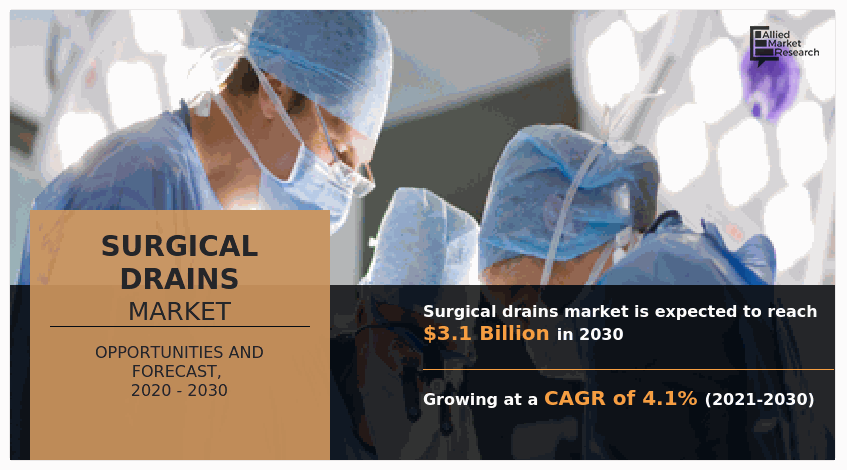
Surgical drains are implants that allow removal of fluid and/or gas from a wound or body cavity. Surgical drains are tubes placed near surgical incisions in the post-operative patient, to remove pus, blood or other fluid, preventing it from accumulating in the body. They are active drains that maintain a negative pressure gradient. Drains can help the healing process by removing inflammatory mediators, bacteria, foreign material, and necrotic tissue. Drains can relieve pressure that can impair perfusion or cause pain, thereby decreasing morbidity and reducing inflammation, they enable monitoring for potential complications by allowing easy sampling of fluid during healing; and they can be used to address complications associated with dead space after a pathology report has determined that neoplasia resection is complete and margins are adequate. The type of drainage system inserted is based on the needs of patient, type of surgery, type of wound, amount of drainage expected and surgeon preference. Surgical drains are composed of a variety of substances, such as latex or plastic and are used in a wide variety of different types of surgery such as breast surgery (to prevent collection of blood and lymph), orthopedic procedures (associated with greater blood loss), and chest surgery (the associated risks of raised intrathoracic pressure and tamponade).
Growth of the surgical drains market size is majorly driven by rise in chronic diseases and increase in incidences and prevalence of chronic diseases (such as cancers and cardiovascular diseases including heart diseases, strokes, and type II diabetes) which have resulted in rise of cardiovascular surgeries and cancer-related surgeries, for instance, cardiovascular disease is one of the leading causes of deaths across the globe. According to the World Health Organization, cardiovascular diseases (CVDs) are the leading cause of death globally. An estimated 17.9 million people died from CVDs in 2019, representing 32% of all global deaths. Of these deaths, 85% were due to heart attack and stroke. Out of the 17 million premature deaths (under the age of 70) due to noncommunicable diseases in 2019, 38% were caused by CVDs which are the key factors that propel growth of the surgical drains market.
Furthermore, increase in geriatric population and technological advancements made in the field of surgical drains and focus of manufacturers on developing advanced and innovative tubes are the key factors driving the growth of surgical drains market size.
However, factors such as increase in number of minimally invasive processes, complications associated with usage of the systems and increase in chances for infection are expected to hamper the growth of the market up to some extent during the forecast period.
The global surgical drains market share is segmented based on product, type, application, end user, and region. On the basis of product, the market is divided into open surgical drainage systems and closed surgical drainage market. By type, it is classified into active drains and passive drains. The application segment includes general surgery, cardiac & thoracic surgery, orthopedic surgery, obstetric/gynecological surgery, and other surgeries. Depending on end user, the market is fragmented into hospitals, and ambulatory surgical centers & clinics. Region wise, it is analyzed across North America, Europe, Asia-Pacific, and LAMEA.
Product Segment review
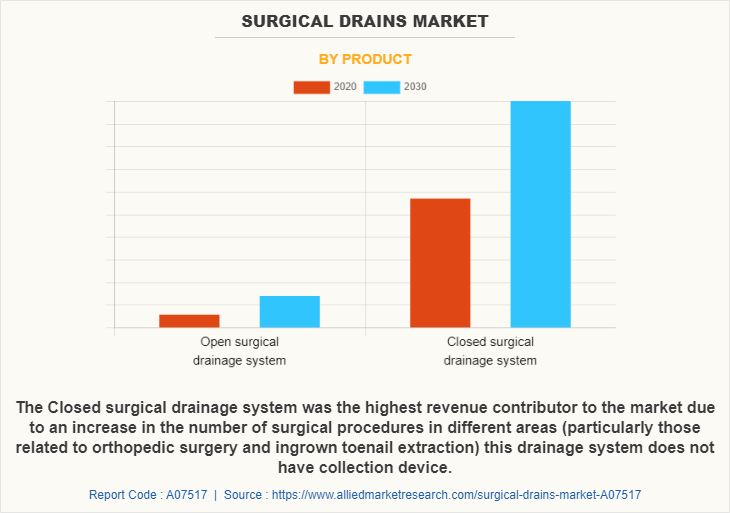
By product type, the surgical drains market segmented into closed surgical drainage and open surgical drainage. The surgical drains market for closed surgical drainage system was the highest revenue contributor to the market, with $1,541.3 million in 2020, and is estimated to reach $2,400.0 million by 2030, with a CAGR of 4.5%. Furthermore, by volume, the surgical drains market for closed surgical drainage system segment was the highest revenue contributor to the market, with 57.4 million pieces in 2020, and is estimated to reach 74.3 million pieces by 2030, with a CAGR of 2.3%. Owing to their accessibility, ability to be used in areas that are difficult to bandage, easy collection of fluid for cytology or chemical analysis with less possibility of environmental contamination of the fluid, ability to minimize the build-up of air along with characterization of fluid, and rise in number of surgical procedures are expected to drive the market growth.
Type Segment Review
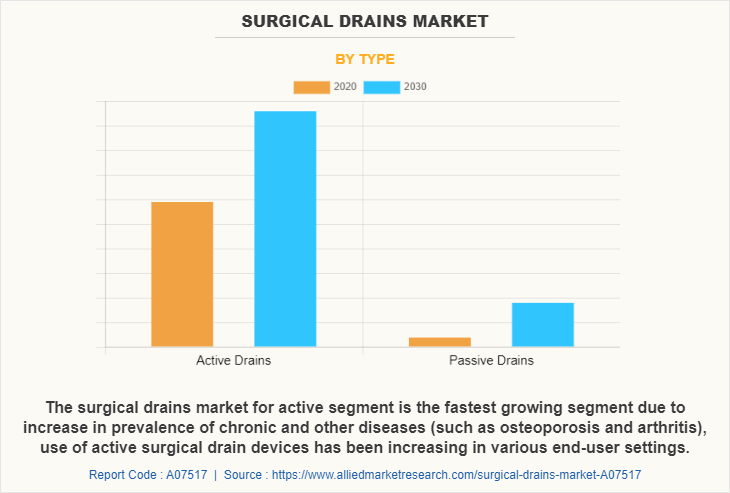
By type, the global surgical drains market is classified into processing passive drains and active drains. The surgical drains market for active drains was the highest revenue contributor to the market, with $1,578.6 million in 2020, and is estimated to reach $2,320.4 million by 2030, with a CAGR of 3.9%. Furthermore, by volume, the surgical drains market for active drains was the highest revenue contributor to the market, with 55.1 million pieces in 2020, and is estimated to reach 68.4 million pieces by 2030, with a CAGR of 1.8 %. Owing to increase in use of active drains due to lower risk of retrograde infections, accurate measurement of drainage. and skin protection from irritating discharge.
Application Segment Review
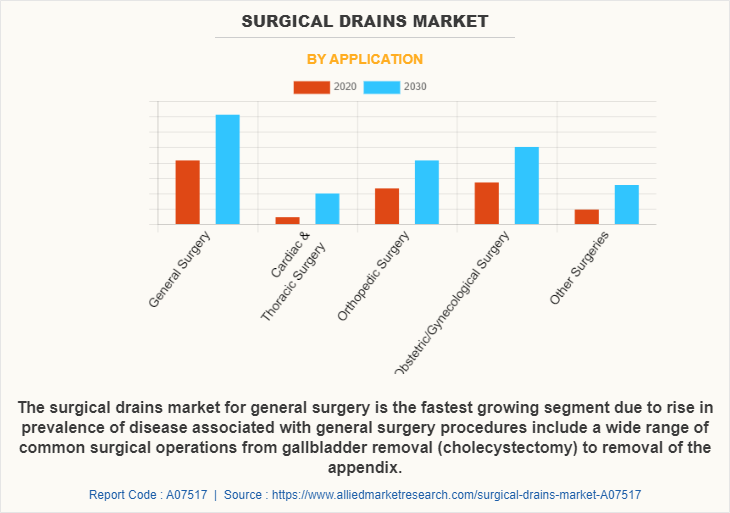
By application, the global surgical drains market is classified into general surgery, cardiac & thoracic surgery, orthopedic surgery, obstetric/gynecological surgery, and other surgeries. The surgical drains market for general surgery was the highest revenue contributor to the market, with $613.7 million in 2020, and is estimated to reach $909.7 million by 2030, with a CAGR of 4.0%. Furthermore, by volume, the surgical drains market for general surgery was the highest revenue contributor to the market, with 22.7 million pieces in 2020, and is estimated to reach 28.4 million pieces by 2030, with a CAGR of 1.9 %. This is owing to increase prevalence of musculoskeletal diseases, such as rheumatoid arthritis, lupus erythematous, and osteoporosis and increasing number of orthopedic procedures, such as hip replacement and knee replacement globally.
End User Segment Review
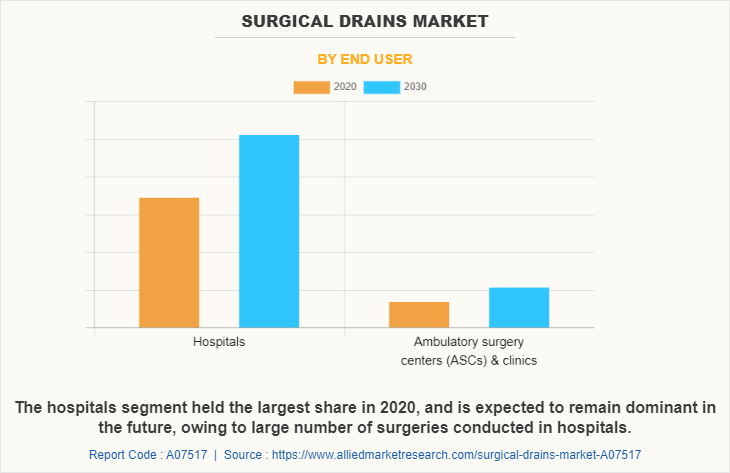
On the basis of end user, the global surgical drains market is divided into hospitals and ambulatory surgical clinics & centers. the surgical drains market for hospitals was the highest revenue contributor to the market, with $1,719.7 million in 2020, and is estimated to reach $2,550.0 million by 2030, with a CAGR of 4.0%. Furthermore, by volume, the surgical drains market for hospitals was the highest revenue contributor to the market, with 47.8 million pieces in 2020, and is estimated to reach 59.7 million pieces by 2030, with a CAGR of 1.9%. Due to a large number of surgeries conducted. The global increase in number of ambulatory surgical centers is another crucial factor that propels growth of the surgical drains market growth.
Region Segment Review
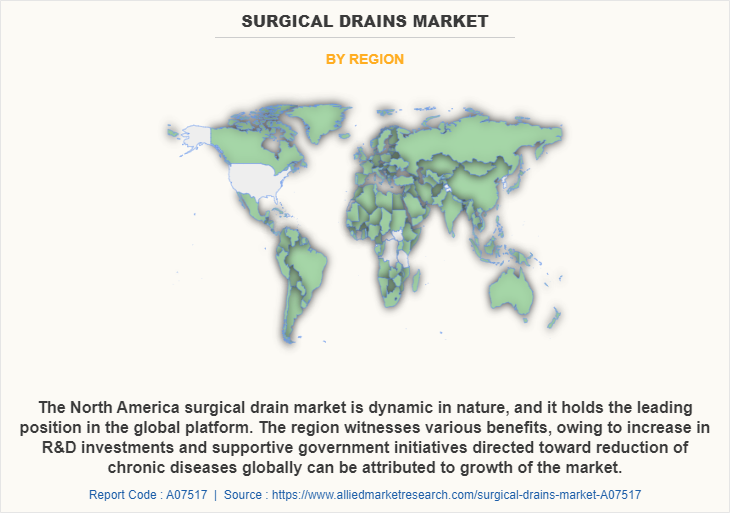
Based on Region, North America was the largest shareholder in the surgical drains market forecast in 2020, owing to its well-established healthcare infrastructure, and supportive government regulations for product type commercialization are the major factors driving the growth of the surgical drains market. However, Asia-Pacific is anticipated to register the highest CAGR of 5.1%. Furthermore, by volume Asia-Pacific is anticipated to register the highest CAGR of 3.7% during the forecast period, due to the increasing penetration of healthcare companies that are investing heavily in the region. Changing healthcare reforms are contributing to the growth of the market by allowing the commercialization of new products.
Key players operating in the global surgical drains market include, such as ConvaTec Group Plc, Cardinal Health Inc., Medtronic Plc, Johnson & Johnsons (Ethicon Inc), Medline Industries Inc, B Braun, Redax S.P.A, Romsons Group Private Ltd, Becton, Dickinson and Company(C.R.BARD, INC.) and Stryker Corporation.
Key Benefits For Stakeholders
- This report provides a quantitative analysis of the market segments, current trends, estimations, and dynamics of the surgical drains market analysis from 2020 to 2030 to identify the prevailing surgical drains market opportunity.
- The market research is offered along with information related to key drivers, restraints, and opportunities.
- Porter's five forces analysis highlights the potency of buyers and suppliers to enable stakeholders make profit-oriented business decisions and strengthen their supplier-buyer network.
- In-depth analysis of the surgical drains market segmentation assists to determine the prevailing market opportunities.
- Major countries in each region are mapped according to their revenue contribution to the global market.
- Surgical drains industry player positioning facilitates benchmarking and provides a clear understanding of the present position of the market players.
- The report includes the analysis of the regional as well as global surgical drains market trends, key players, market segments, application areas, and market growth strategies.
Surgical Drains Market, by Product Report Highlights
| Aspects | Details |
| By Product |
|
| By Application |
|
| By Type |
|
| By End User |
|
| By Region |
|
| Key Market Players | MEDLINE INDUSTRIES INC., REDAX S.P.A, CONVATEC GROUP PLC, BECTON DICKINSON & COMPANY (C.R.BARD, INC.), ROMSONS GROUP PRIVATE. LTD, STRYKER CORPORATION, JOHNSON & JOHNSON (ETHICON INC.), CARDINAL HEALTH INC., MEDTRONIC PLC., BRAUN MELSUNGEN AG |
Analyst Review
In accordance to several interviews conducted, the surgical drains market is expected to witness a significant growth in the future, owing to benefits of drains such as ease of use and less chances of infections.
According to perspectives of CXOs, the global surgical drains market is expected to witness a steady growth in the future. Rise in geriatric population, rise in number of surgeries, and increase in incidences of target diseases propel growth of the market. In addition, increase in tobacco and alcohol consumption and rise in number of cancer-related surgeries further propel growth of the market.
However, factors such as increase in number of minimally invasive processes, complications associated with usage of these systems, and increase in chances of infection are expected to hamper growth of the market during the forecast period. On the contrary, rise in technological advancements and increase in government initiatives for surgical drains are expected to drive growth of the global surgical drains market.
The current and upcoming trend in the industry is the increased utilization of closed surgical drains in a number of surgeries owing to their varied advantages and ease of use.
Europe is the largest regional market for surgical drains industry due to the increasing surgeries of abdominal surgery, breast surgery, mastectomy, and thoracic surgery
The global surgical drains market was valued at $2,054.0 million in 2020, and is projected to reach $3,075.2 million by 2030, registering a CAGR of 4.1% from 2021 to 2030. Furthermore, on the basis of volume, the global surgical drains market was estimated at 75.5 million pieces in 2020, and is projected to reach 95.5 million pieces by 2030, registering a CAGR of 2.0% from 2021 to 2030.
ConvaTec Group Plc, Cardinal Health Inc., Medtronic Plc, Johnson & Johnsons and Romsons Group Private Ltd
Loading Table Of Content...



